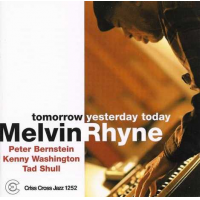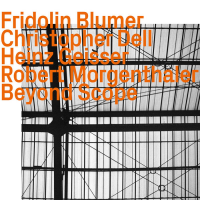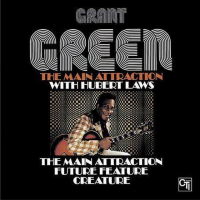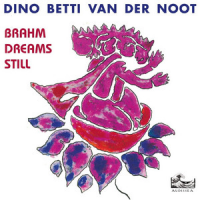Home » Jazz Articles » Liner Notes » Dino Betti van der Noot: They Cannot Know
Dino Betti van der Noot: They Cannot Know
"I like to tell stories," says Dino, "to show emotional itineraries through my music. I like to write melodies you can remember and unusual chord progressions able to make them more memorable."
Even when Betti van der Noot is, as he puts it, "involved in modal patterns," he tends "to use them in an almost tonal way. I love to do a certain kind of tonal ambiguity (Is it major or minor? Is it C or D?). Sometimes it is difficult to understand the tonality up to last bars of a theme."
Betti van der Noot is obviously a man of rich imagination. What inspires him? As you will hear it may be the essence of a day, something from his background or that great, universal inspirator, love. A theme may be followed to fruition soon after insinuating itself into his consciousness or gain full life after lying dormant on a page of manuscript for months—or even years. Dino pursues his muses in an unforced manner. There is no writing on demand. "That I save for my jingles," he explains.
Betti van der Noot is chairman of a successful Milanese ad agency, B Communications, which might prompt one to think that writing jazz is his hobby. Make no mistake, here we have no mere hobbyist but a sensitive, inventive melodist and lapidarian master of orchestral skills, aquired by doing, after studies in Italian music schools, the Berklee College of Music in Boston and from listening to those talents he admired.
In the liner notes to Here Comes Springtime Betti van der Noot's list of favorites includes (last names only): Ellington, Kenton, Tristano, Basie, Herman, Lewis, Davis, Mingus, Monk, Evans, Gaslini, Gibbs, Ayler and Coltrane. Due to his position as a writer, I assume that Dino was talking about Lewis, John; Evans, Gil; and Gibbs, Mike, the latter also in light of the Berklee connection. Betti van der Noot's orchestras began in 1970, starting with amateurs and graduating to the top pros who were both challenged and gratified by his charts. One big band from 1984 recorded an earlier version of A Midwinter Night's Dream. I did not become aware of him until Here Comes Springtime which both intrigued and delighted me with its vividly varied palette, both in the writing and the way the soloists were inegrated into each overall performance. Dino says that he employs "unusual chord progressions" not only to make his melodies "more
memorable" but "also to stimulate the improvisers' fantasy in the way I need to complete the whole composition."
Improvisers he has in abundance, both homegrown and imported. On Here Comes Sprintime American solists included alto and soprano saxophonist Donald Harrison; bassist Bob Cunningham; and pianist Mitchel Forman. With them were the Italians, Franco Ambrosetti (Swiss-Italian) and Rudy Brass, flugelhorn; Gianluigi Trovesi, E-flat clarinet; Luca Bonvini, trombone; and Hugo Heredia, alto flute and baritone saxophone.
Forman, Brass, Trovesi and Heredia are back; the new soloists are discussed below as they relate to the individual tracks. The make-up of the orchestra reflects Betti van der Noot's kaleidoscopic conception of his compositions. "Working with musicians of different origins and styles (here you can find Americans, Italians and Latin Americans) to whom I try to offer a fresh—maybe different—approach to enhance their improvising capabilities.
"The orchestra, finally, is in my opinion something to be mixed and changed continuously, to get the sound I need in any particular moment."
To this end Dino uses vibes, cello, percussion and the human voice, as well as the conventional sections with liberal use of mutes for the brass, and flutes and clarinets to complement the various members of the saxophone family.
The composer describes his title track, They Cannot Know, as "in a way, a love story, with its sudden explosions and moments of no-time. The theme is quite long and complicated, in spite of the fact that it is based mainly on just one chord, changing only during the bridge. I wrote for the second flute in order to have it always late comparing with the other instruments—sort of a faraway fading echo."
Trumpeter Rudy Brass, bearing a name that fits his instrumental category, is definitely not brassy here, using a cup-mute for a delicate, plangent solo that advances the romantic intentions of the piece. The Bill Evans, known for his tenor saxophoning, when he was a member of Miles Davis' band, makes his debut on alto sax, displaying a tart sound that builds to a keening height of emotion as the band swells behind him and Mark Egan's electric bass occasionally takes on almost tuba-like qualities. Egan, who has been featured with Pat Metheny and is presently with Gil Evans, is a frequent colleague of Bill's.
Gianni Farè's vibes, which have made an earlier appearance, and then emerge from the background textures from time to time, reappear, biefly, before the main theme is reintroduced, prefaced by Attilio Zanchi's cello. Mitchel Forman's piano helps with the signature.
"Midwinter Sunshine" is in 12/8, its theme carried along by the wordless vocalizing of Carmen Lundy, a young woman who has been garnering a following in New York jazz circles, slowly but solidly. Dino explains that this piece "was born under
the influence of one of those metaphysical winter days when sunshine is almost unreal, like being on a strange science fiction planet."
Sergio Fanni's flugel is fluent and mellow and then bites a bit, leading into a free for all among five tenor saxophones: Evans, Heredia, Riccardo Luppi, Marco Visconti and Peppino De Mico. "Every unexpected contrast can be expected," says Dino of his planet, and soon there is another collective improvisation among Lundy, Luppi, cellist Zanchi, percussionists Luis Agudo and Tiziano Tononi and drummer Danny Gottlieb. The latter, like Egan, with whom he attended the University of Miami, has been with Pat Metheny and, now, Gil Evans. Egan's bass brings back the Lundy-led ensemble chant, with its arresting bridge, and an abrupt end.
Insieme, which means ensemble and subtitled, parenthetically, by Betti van der Noot, together, is a composition he wrote back in 1982 and didn't record until now beacuse, as he explains: "its difficulty. Actually, it is a mixture of 2/4, 3/4, 4/4 and 5/4, and that's why it gives (particularly in the first part) such a feeling of rhythmic uncertainty. The bass tries, little by little, to find its way through a pattern made by a simple melody based on a two-note (G-D) ostinato chord. I made use of different metrics in order to have the melodic line almost suspended between a basic metric—without a regular beat—out of logical accents."
Luca Perreca's cello introduces the piece before the brass presents the kind of western United States theme, a new day dawning, perhaps over a real mesa, rather than a surreal planet. The main soloist is Mitchel Forman, first heard by many when he was with Gerry Mulligan and, more recently, with Carla Bley. He gives the Steiway his nimble fingers, using a two-handed rhythmic attack effectively in one segment. The sound of his piano is a constant thread, from the cello opening to the amen after the theme restatement.
The starting point for Memories from a Silent Nebula was, according to Dino, "the echo of a Magnificat, that I transformed in a way that filled my expressive needs. This composition goes back to my cultural roots. I was always fascinated by Gregorian hymns and their essence still continues to come to the surface through banks of more recent experiences."
Zanchi and Egan, with Forman and Dana Hughes (bass trombone) in the background, carry the grand but solemn theme. Then Forman and Farè create the next texture; Forman solos, the orchestra cresting behind him; Evans begins as a lone tenor before the orchestra builds in intensity again. When the theme resurfaces, the bass is dominant with the cello trailing in its wake. Agudo mutters in a non-existing language, a monk at the other side of a cavernous cathedral.
Forman opens A Midwinter Night's Dream ruminatively, aided then by Farè and Egan. Dino calls the evanescent theme "a lonely tale of many encounters—or perhaps a dreamed love story where many things happen." Trovesi, on E-flat clarinet, enters, birdlike, and floats through a luminous solo; Giancarlo Schiaffini's trombone is more stark, but with tongue-in-cheek humor; and Heredia's lovely, fanciful alto flute closes the soloing. The lightly dancing theme, with its tonal contrasts of muted trumpet and flute, and electric bass, returns. The Forman's piano wakes you gently from the dream.
In a review of Here Comes Springtime, Cadence magazine's Robert Iannapollo wondered what Betti van der Noot could do "with a straight ahead chart." In Jeu de Pommettes he gets his wish. Dino tells us it "means, literally, Cheekbones Game" and then reveals a funning side by adding, "actually reminding of the Jeu de Paume museum too."
Gottlieb's drums are the power plant at the hub of a riffing, driving ensemble from which spring Evans' high-spirited, energetic tenor and Schiaffini's plunger-muted trombone, the latter darting in and out of the various riff pattern with alacrity ans élan. Dino calls this a "tribute to Count Basie and his men." I also hear Kenton and Mingus in there as well.
The very name, Dino Betti van der Noot, fascinated me and I asked our main protagonist about the Italian and even more western European derivations. "My family helped to found the city of Brussels," he explained. "They were quite combative people."
I suspect that there were a few poets among them.
—Ira Gitler
Liner Notes copyright © 2026 Liner Notes copyright © 2023 Dino Betti van der Noot..
They Cannot Know can be purchased here.
Track Listing
They Cannot Know; Midwinter Sunshine; Insieme; Memories From A Silent Nebula; A Midwinter Night's Dream; Jeu de Pommettes.
Personnel
Dino Betti van der Noot
composer / conductorAlbum information
Title: They Cannot Know | Year Released: 1987 | Record Label: Soul Note
Tags
About Dino Betti van der Noot
Instrument: Composer / conductor
PREVIOUS / NEXT
Support All About Jazz
 All About Jazz has been a pillar of jazz since 1995, championing it as an art form and, more importantly, supporting the musicians who make it. Our enduring commitment has made "AAJ" one of the most culturally important websites of its kind, read by hundreds of thousands of fans, musicians and industry figures every month.
All About Jazz has been a pillar of jazz since 1995, championing it as an art form and, more importantly, supporting the musicians who make it. Our enduring commitment has made "AAJ" one of the most culturally important websites of its kind, read by hundreds of thousands of fans, musicians and industry figures every month.






















